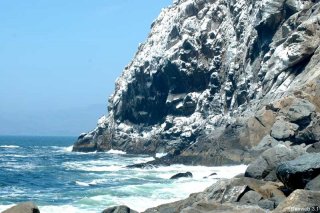Just got back from my second trip to California this summer, and third this year. I wonder if I should just move there? Seriously, though, it was good to get out and see the rest of the family (3 of the 4 grandsets), and the landscape. After my trip in January, I was reminded of just how beautiful the place really is.
One of my favorite places is a lovely little town called Morro Bay, which, as you can see from the map below, is not far from the lovely cities of San Luis Obispo and Atascadero, and is just north of one of the more dramatic but lesser known of the California state parks, Montana de Oro.
View Larger Map
One of the first things you notice about Morro Bay as you approach on any of the roads leading to the town, is the Great Big Rock. Go ahead and click through, it’s just a Google Image search; any of the images on that page will be better than any of the photos I’ve managed to take of the place. To get a good shot of this giant mound, you need to have the time to devote to planning your shot and figuring out the light and the angle and etc. If you just want to take a snapshot, you’ll be lucky to capture even an acceptable, let alone a good, image of this gigantic morro,* as you can see from my shot below:
So, lacking the time and talent to take pretty pictures, I have to resort to noticing other things and taking pictures of them.
One of the things I noticed about Morro Bay is that there are an inordinate number of seafood restaurants. Like all coastal communities, there are a lot of them. But you can’t find a restaurant in this place that doesn’t boast of the freshest seafood, the best clam chowder, etc. On our trip, the gang (me, Marcella, my brother, his wife and two sons; Eric stayed home with Mémé and Pépé) went into one of them, basically at random, and sampled the fare. Most of us had the clam chowder and half sandwich plate. The chowder was indeed excellent; the clams were actually tasty and with a pleasing texture, unlike 98 percent of the clam chowders out there. Trouble was, it was served barely lukewarm. Hard to work up much enthusiasm for a dish that isn’t properly prepared. And no one wants to be the one to send something back to the kitchen; too many urban legends (at least, I hope they’re urban legends!) about what happens to the dishes that go back…
This Western Gull (Larus occidentalis) had a similar experience at another local eatery: s/he can certainly testify to the abundance and the freshness of the seafood offered in the vicinity of Morro Rock, although I bet that, like us, s/he would have preferred the chef to take a few more pains in the preparation of the dish; it was quite a puzzle to figure out how to swallow!
When we left the town and visited the rock, we found that a couple of volunteers had trained a spotting scope on the famous Peregrine Falcon roost there (How I wish I’d had that link before we went there!), and the whole family, at least those that were interested, had the opportunity to take a look. My nephews wanted to climb the rock, as did I the first time I saw it, but we were deterred by the strongly worded sign warning of the prosecution that would surely ensue. That, plus the possibility of being divebombed by unhappy roosting gulls and, worse yet, unhappy roosting Peregrine Falcons, was enough to convince us to take our climbing needs to the ginormous rip-rap breakwater that “protects” the harbor at Morro Bay. (I put the word in quotes because the harbor there is notorious for the difficulty of access; you have to turn broadside to the swells to get in or out. I quote the Wikipedia article:
Mariners are strongly urged to seek local advice prior to making use of the channel, especially when whitecaps or wind-blown water is evident or a small craft advisory is in effect, which is very often. The United States Coast Guard regards the harbor as one of the most dangerous in the entire nation, while others put it in the top six on the West Coast of the United States. In 1995, the Army Corps of Engineering deepened and expanded the channel to improve safety. From 1979 to 1987, 21 lives were lost in boating accidents alone. However, many additional deaths have resulted from sightseers and fisherman being swept off the rocks of the breakwater surrounding Morro Rock. They often approach too closely to the waves and are caught off guard when a big wave set comes in. The slippery and jagged rocks only add to the danger. Public access to the breakwater has been revoked and those who venture beyond the signs do so at their own peril.
So be careful when boating around Morro Bay!
*The name of this most prominent geographic feature comes from the Spanish morro, and dates to 1542, when Juan Rodriguez Cabrillo charted the prominence for the Spanish. If you believe the Wikipedia article, Cabrillo had a good sense of humor, or at least a penchant for understatement, when he called it El Morro, which can be translated as “pebble.” Unfortunately, this is a bit misleading. According to my American Heritage Spanish-English dictionary, el morro can also be translated as knoll, hillock, pier, and jetty; my Collins unabridged adds “headland, promontory; =cerro small rounded hill.” So to restrict the word to the humorous understatement, “pebble,” is to overstate the case, so to speak…



























